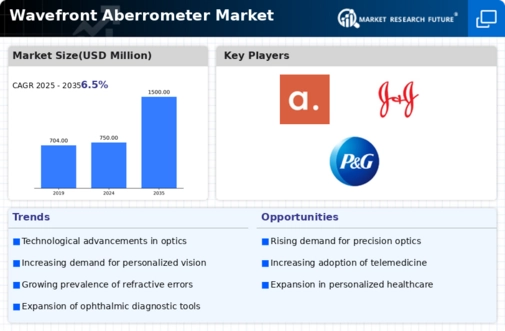Market Growth Projections
The Global Wavefront Aberrometer Market Industry is projected to experience substantial growth over the next decade. With a market value of 750 USD Million anticipated in 2024, the industry is expected to expand significantly, potentially reaching 1500 USD Million by 2035. This growth trajectory suggests a compound annual growth rate of 6.5 percent from 2025 to 2035. Such projections are indicative of the increasing adoption of wavefront aberrometers in clinical settings, driven by technological advancements, rising awareness of vision disorders, and the demand for customized treatment solutions. The market's expansion reflects a broader trend towards enhanced eye care and precision medicine.
Technological Advancements
The Global Wavefront Aberrometer Market Industry is experiencing rapid technological advancements that enhance the precision and efficiency of vision correction procedures. Innovations in wavefront sensing technology allow for more accurate measurements of ocular aberrations, leading to improved patient outcomes. For instance, the integration of artificial intelligence in aberration measurement systems has shown promise in refining diagnostic capabilities. As these technologies evolve, they are expected to drive market growth, with the industry projected to reach 750 USD Million in 2024. This trend indicates a growing demand for advanced diagnostic tools in ophthalmology, which may further stimulate investment in research and development.
Increasing Prevalence of Vision Disorders
The rising incidence of vision disorders globally is a significant driver for the Global Wavefront Aberrometer Market Industry. Conditions such as myopia, hyperopia, and astigmatism are becoming increasingly common, necessitating advanced diagnostic tools for effective management. According to health statistics, the prevalence of myopia alone is projected to reach 50 percent of the global population by 2050. This alarming trend underscores the need for precise measurement technologies, such as wavefront aberrometers, to facilitate personalized treatment plans. As awareness of these disorders grows, the market is likely to expand, potentially reaching 1500 USD Million by 2035.
Regulatory Support and Reimbursement Policies
The Global Wavefront Aberrometer Market Industry is positively influenced by supportive regulatory frameworks and favorable reimbursement policies. Governments and health organizations are increasingly recognizing the importance of advanced diagnostic technologies in improving patient care. As a result, there are initiatives aimed at streamlining the approval process for new devices and ensuring that they are covered by health insurance plans. This regulatory support not only encourages innovation but also enhances the affordability of wavefront aberrometers for healthcare providers and patients alike. Consequently, this trend is likely to bolster market growth, making advanced eye care technologies more accessible.
Rising Awareness and Accessibility of Eye Care
The Global Wavefront Aberrometer Market Industry benefits from increasing awareness and accessibility of eye care services. Public health campaigns and educational initiatives have significantly improved knowledge about eye health, leading to more individuals seeking regular eye examinations. This heightened awareness is crucial, as early detection of vision problems can lead to better treatment outcomes. Furthermore, advancements in telemedicine and online consultations have made eye care services more accessible, particularly in underserved regions. As more patients seek diagnostic services, the demand for wavefront aberrometers is expected to rise, contributing to the overall market growth.
Growing Demand for Customized Vision Correction
The Global Wavefront Aberrometer Market Industry is witnessing a surge in demand for customized vision correction solutions. Patients are increasingly seeking personalized treatments that cater to their specific visual needs, which wavefront aberrometers are uniquely positioned to provide. These devices enable eye care professionals to create tailored refractive surgery plans based on individual aberration profiles. As a result, the market is expected to grow at a compound annual growth rate of 6.5 percent from 2025 to 2035. This trend reflects a broader shift towards patient-centric care in ophthalmology, where customized solutions are becoming the norm rather than the exception.














Leave a Comment